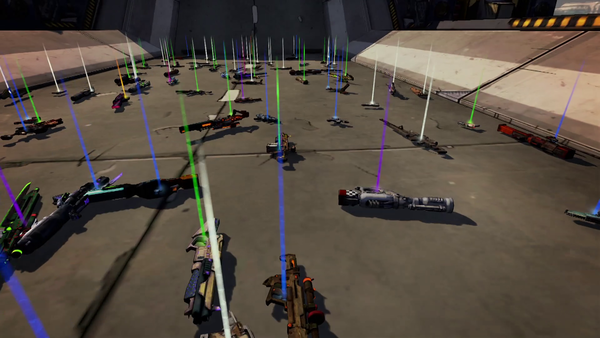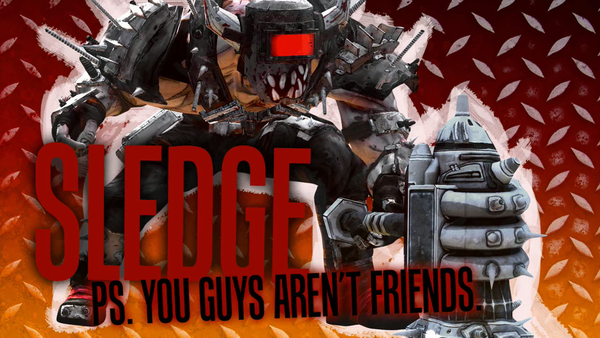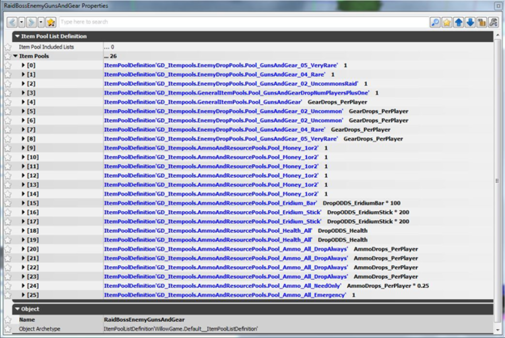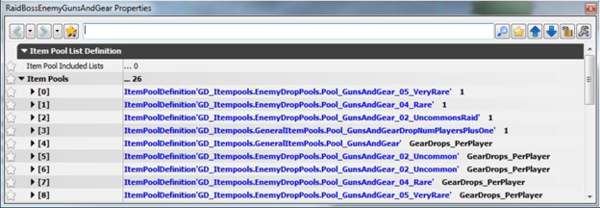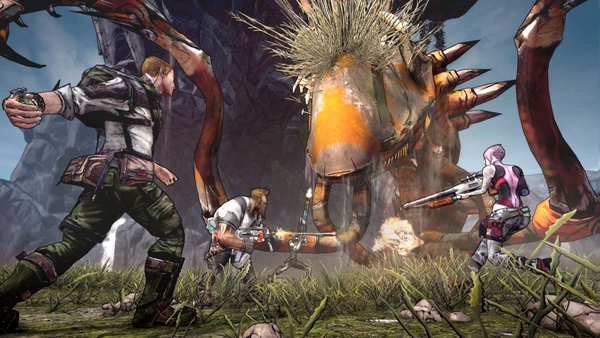
Inside the Box serves as a forum for individuals involved in the production of Gearbox Software content to share personal motives, methods, process and results. Gearbox Software projects are created by a diverse range of individuals spanning a spectrum of different backgrounds, interests, objectives and world views. The views and opinions expressed in this article are those of the author and do not necessarily reflect the official policy or position of Gearbox Software or any of its individual members outside of the author.
Hello everyone, Paul Hellquist, creative director for Borderlands 2 here again. A few weeks ago I wrote about how the loot system works on Borderlands 2. I encourage you to read that first here if you haven’t since I’m writing this under the assumption that you know what is covered there. At the end of that article I asked you guys to send in your questions about loot so I could figure out what tell you about next. You guys were very vocal and I got a lot of inquiries from all channels. Thanks to everyone who chimed in!
The questions covered a wide range of topics around loot. I had originally thought that I would do an FAQ style article with quick answers to a lot of questions. Once I saw what the questions were it became clear that there were a couple of questions that were the most common and to fully answer the questions I would really need to dig into them. Thankfully their stories are all related so I should be able to get you some answers.
The most common questions were:
- Why don’t the enemies in Borderlands 2 drop what they are carrying like they did in Borderlands?
- Why are the drops rates in Borderlands 2 different from those in Borderlands?
- You told us how chumps work, how do bosses work?
Let’s get to it!
Once upon a time…
…way back in 2010 when we started working on Borderlands 2 I started doing an analysis of the loot system to see where we could improve on it. I scoured the forums and our mailbox and asked around the studio for opinions. There were 2 things that were the most common criticisms that I heard. They were:
- “I got a gun around level 15 and used it until level 50. The loot collection part of the game basically was non-existent after I got that gun.”
- “Bosses never drop good loot!”
It was then time to analyze the game and those statements and try to figure out what caused those feelings.
Same gun, different day
In a loot game it is important that you find loot that excites you. It is also important that you continue to find loot that excites you throughout the entire game. In Borderlands we succeeded on the first point but missed the mark with a lot of players on the second point. Many players would find a high end gun in the mid game around level 15-20 and use that weapon for the rest of the game through both playthroughs, or at least use it for many, many levels before finding something they felt was an improvement.
When this happens the excitement of loot drops gets staler and staler as you feel there is very little out there that can improve upon the weapon you are using. This feeling can make a large portion of the Borderlands gameplay loop fall flat.
When I investigated further I determined that the heart of the issue was in the growth curve of enemy health and weapon damage compared to gamestage. The rate at which the damage increased with weapon level and the amount of health the enemies had at each level was relatively flat. This meant that there was not a big difference in the damage the player could deal with a level 15 weapon and a level 30 weapon allowing the increase in player skill and the expenditure of skill points to essentially allow the low level weapon to maintain its effectiveness at higher levels.
Crank it up!
In a game with millions of pieces of gear it is a shame for people use the same weapon for a thirty level period. My mission became to try and get players to use a weapon for a much shorter period than in Borderlands so that players would explore the massive breadth of weapons and gear that the game provides instead of using Sledge’s Shotgun for the entire game.
Strangely, the solution came from looking at the economy in Borderlands which used a compounding interest model so that you started out buying things for 10 dollars but by the end of the game you were buying items for millions of dollars. The curve of the economy grew dramatically with each level you gained.
I took this model and applied it to the damage of weapons and health of the enemies. What this method provided was a significant difference in the damage stat of a weapon that was a level higher than the one you were using. When your weapon becomes about 4 levels old the damage number on the new weapons dropping is so much larger that you will generally upgrade because the old weapon just can’t hit hard enough to keep up with the health of the higher level enemies.
Next I needed to look at boss loot.
Boss loot!
Boss loot in Borderlands was, in fact, better than the loot from a chump. To explain why it felt crummy I need to explain a bit about how rarity was determined in Borderlands. In Borderlands rarity came from the parts that combined to make the weapon. Each part had a value. The game would add up the values of all of the parts and if it landed within the “green range” the item would be green. The more higher value parts there were the more rare the weapon.
To illustrate let’s imagine a gun with 3 parts. Each part has a rarity value of 5, 10, and 10 respectively. Together they are worth 25 points. Now imagine that the scale that determined rarity is like this:
- 0-10 points = white
- 10-20 points = green
- 20-30 points = blue.
In this example our imaginary gun would be a blue weapon.
What this method of determining rarity meant was that designers only had control over the rarity of loot when determining the value of a part. When it came to determining what was dropped from an enemy all we could say was what types of gear (gun, shield, grenade, etc.) we wanted. The only control over rarity we had was in a value called “Awesome Level.” The awesome level was simply a factor that influences the weight of the parts so that the game was more likely to use parts with higher rarity values to generate the gear, it did not allow us to request any particular rarity of gear to drop. To say it a different way: We had no direct control over the rarity of the weapons that would drop.
You could set the awesome level on a boss to some ridiculously high number and he might drop 5 legendaries with one kill and drop all whites the next time you kill him.
Question answered!
What does all of this mean? It means I’ve finally answered one of your questions!
The drop rates in Borderlands 2 are so different from those of Borderlands because there were no drop rates in Borderlands! (I feel like I should drop the mic after that statement.)
Let me reiterate, in Borderlands 1 there were no drop rates as described in my previous article. We could only set the rarity of the parts and then various enemies, chests, vending, etc would have awesome levels that could influence the way a gun was generated to give better chances for rare loot. While it sounds similar it is in fact very different. The easiest way to describe the difference is that in Borderlands we could just suggest that the enemy drop better loot, we could not demand it.
With Borderlands 2’s method I could say, “Sledge, you will drop 3 whites, 2 greens, 1 blue and give me a 10% chance for a purple, and a 1% chance at a legendary.” With the first game’s method all I could say is, “Sledge, pretty please drop better stuff than usual.” Sometimes he would, and sometimes he wouldn’t.
Sometimes in Borderlands Sledge was nice and dropped lots of loot. Sometimes he just kept it all.
The major difference that most long time BL2 players are actually feeling between the two games is that the way Borderlands worked with the awesome level is that the higher level you were the higher the awesome level was so you got more rare drops the longer you played, the new system does not do that. Your chances at good loot are the same throughout the entire game.
Back to the drawing board
So, to solve the issues of using the same gun forever and lousy boss loot we had to completely redesign how rarity was determined for gear. We eliminated the concept of awesome level and removed the notion of the parts affecting the rarity of the gear. Instead we made one specific part of the weapon determine the rarity of an item which allowed us to make item pools that could reference the rarity directly ensuring an item of a particular rarity.
When the rarity is chosen it also applies modifiers to the damage of the weapon. Each rarity level is like adding 2 levels worth of damage to the weapon. So if you have a level 10 green weapon its damage is on par with a level 12 white weapon. A level 10 blue weapon’s damage is like a level 14 white weapon, or a level 12 green weapon, and so on.
These changes to the scale of damage and how rarity affects damage means that eventually you care about the entire range of rarities again as you level up. When you are significantly higher level than your gear a white at your level can be better than the really old blue you are using.
Our user data shows that I succeeded in my mission of having players change their weapons more frequently and the anecdotal stories from the public have supported this as well. I’m very happy with the change and outcome of redesigning how rarity works and the scale of damage in the game.
Common side effects include…
Unfortunately these changes did not come without a price. With the dramatic increase in the scale of damage with level and how weapon rarity significantly affected damage affected combat in an unexpected way.
In Borderlands the weapons the enemy could drop used the same item pool as the weapons they would shoot. This design resulted in that cool feeling of seeing an enemy use an interesting weapon and you could kill him and collect his weapon to use as your own.
Once the damage scale was increased and we now had control over drop rates an interesting side effect occurred. Since they used the same pool for their gun as they did for the drops there was now a 1 in 10 chance that an enemy was shooting a gun 2 levels better than you. There was a 1 in 100 chance they were shooting a gun 4 levels higher than you, and a 1 in 1000 chance that you just got one-shot by a chumpy bandit marauder wielding a super powerful purple.
When we starting playing the game with the new scales the combats got completely unpredictable and the game balance of combat went out the window. We now had awesome control over the drops but terrible control over the power level of the enemies resulting in the same fight being super easy sometimes, a good challenge others, and unreasonably too difficult the next. It was even highly variable from enemy to enemy within the same combat encounter. We needed more control over the combat experience to ensure that the game was fun.
In order to achieve combat balance we needed to make different item pools for the weapons enemies could shoot from the pools they dropped as loot. While it’s a bummer we lost this feature, I felt that the benefit of the control over drops and a way to make weapons “age out” as you level was well worth the tradeoff.
Two down, 1 to go!
I’ve now answered two of the three questions. The last one is about how bosses drop loot which nicely matches one of the other goals for gear that I had when starting BL2. I wanted to address, “Bosses drop crappy loot!” comments and the answer to your question will illustrate how I tried to solve that.
I believe people were saying the bosses had lousy loot for two reasons. The first is that we had very little control over the rarity of the drops so we couldn’t be confident in the quality or quantity of the rare drops. The second reason I believe people felt the bosses didn’t often drop good loot is that players generally had a lot of higher rarity gear prior to the fight. When you are using all purple gear getting 3 blues from a boss still feels like lousy loot even though you’ve never gotten 3 blues from a chump during hours of play. The evaluation of “good loot” is completely dependent on the loot you are already using. What people actually mean when they say “Bosses drop crappy loot!” is, “That loot was not better than what I already had!”
One way to help with this feeling is to make rare loot rarer. I decided to use that as one tool towards resolving this feeling of “crappy loot from bosses” by making the rarer loot in the game drop less frequently from the chump enemies.
The other way is to use the newfound control over drops that we had in Borderlands 2 to ensure a good range of quality and quantity from defeating a boss.
The first thing to understand is that there are 5 different configurations of list definitions that are used for bosses and rare spawn enemies. I’m not going to go into the details of all of them but here they are in order of least gear to most gear:
- Badass
- Super badass
- Ultimate badass
- Chubby
- Raid
The named bosses from side missions usually use the Badass list definition as do all of the random spawn badasses in the game. Plot bosses generally use Super Badass and Raid definitions. There are very few ultimate badasses, the most common example being letting a varkid cocoon 3 times. Chubbies are your plump rare spawn enemies that could show up pretty much anywhere in the game. You should be very happy to see a chubby as they drop the most loot outside of raid bosses. There are only 3 enemies that drop raid boss levels of loot in the shipping title without DLC: Terramorphous, the Warrior, and BNK-3R.
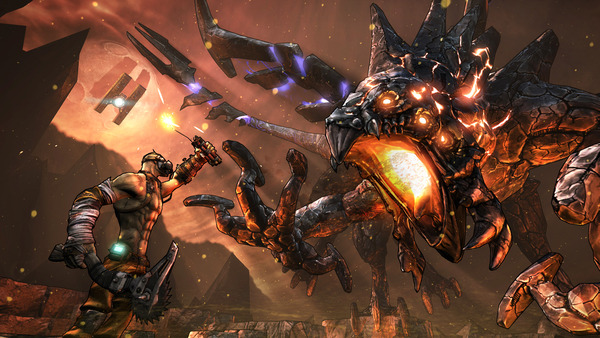
Run, Boss, Run!
In Borderlands we have this notion that any boss should be runnable so that players can fight them multiple times to experience the battle again and have multiple chances at the better loot. Unfortunately, in Borderlands there was very little reason to do so. The main reason for this is that the bosses always dropped their unique item 100% of the time. So you really only needed to fight each of them once in order to collect all of the unique loot. This design was something that I wanted to improve on so that players had more things to do in the late game and more bosses to interact with if they wanted to collect all of the legendaries in the game.
To that end I divvied up all of the legendaries and assigned one of them to each boss. So each boss has one specific legendary item that they are the most likely place to get the item. As I mentioned last time every enemy in the game has a chance for a legendary to drop from them at a rate of 1 in 10000. Bosses have a 1 in 30 chance of dropping their assigned legendary weapon. That still sounds rare but it is over 300 times better chances than from a normal enemy!
Another goal of this design was to create a system that the community could uncover and then share the information about which boss drops which legendary. We hoped that it would create something for players to talk about and share knowledge with each other.
It’s a raid, Boss!
Now I’ll go into some detail about how the raid bosses drop loot in the main title using Terramorphous as the example. The following is the list definition for raid bosses:
25 different item pools! Raid bosses can drop a lot of stuff. You guys don’t care about health, ammo, money, or eridium though so this is what you really want to know:
This image is just a zoomed in version showing only the gear related sections of the list definition. When looking at the image remember that the number after the pool name is the chance that the pool will drop an item (1=100% chance).
As you can see you are guaranteed 1 purple, 1 blue, a drop from the “UncommonRaids” pool and a drop from GunsAndGearDropNumPlayersPlusOne pool. The other ones are using the “GearDrops_PerPlayer” attribute as the chance of the pool dropping.
The “UncommonRaids” pool is a special pool which has all of the uncommon gear in the game in it except it has a quantity of 2 so you are guaranteed 2 greens.
The GunsAndGearDropNumPlayersPlusOne pool is interesting and is one I made specifically for Raid bosses. It is a pool that has all of the gear in the game following the same rarity chances as a chump, but it drops from this pool equal to the number of players in the game plus one. So if you have 1 player in the game it will drop 2 items from this pool. If you have 4 players in the game it drops from this pool 5 times. This pool usually gives you whites, but your chances at an additional higher quality drop are worthwhile with more players.
The bottom 5 pools in the image give you a chance to get extra items from those pools. The first gives you an extra chance for any item of all rarities. The ones below that drop an item of the matching rarity. The real question is “What does GearDrops_PerPlayer?” equate to? Well, here you go:
GearDrops_PerPlayer
| Players | Probability |
| 1 | 5% |
| 2 | 10% |
| 3 | 15% |
| 4 | 20% |
So do your raids with more people! With 4 players you should get at least 1 extra piece of gear and have a reasonable chance at even more.
Cuz Ruben loves you…
Now the kicker to all this is that Terramorphous spawns items from this list 4 times every time you kill him! You have Terramorphous’s designer Ruben Cabrera to thank for all that loot. He insisted that we spawn a zillion items when you kill him.
Uniques of Terramorphous
Being the major raid boss in the shipping title Terramorphous got a lot of special stuff in his unique item pool. Instead of only having one legendary in his unique pool he had a whole suite of stuff in his 1 in 30 pool. He had a unique item of every type (Gun, Shield, Relic, Grenade) that were all named “[Blank] of Terramorphous.”[1] He also has a legendary skin and head as well as the Pitchfork sniper rifle. The chances of getting any of these items is equally weighted.
Unlike most named bosses you actually get 2 rolls on the unique pool so you actually have a better than 1 in 30 chance of getting one of those special items.
Til next time
As usual, what I think is a small topic is massive! Unfortunately, that’s all I have time for today. I expect there will be more loot related articles in the future but in the meantime visit the forums to chat or send us mail at [email protected] or tweet me @TheElfquist.


